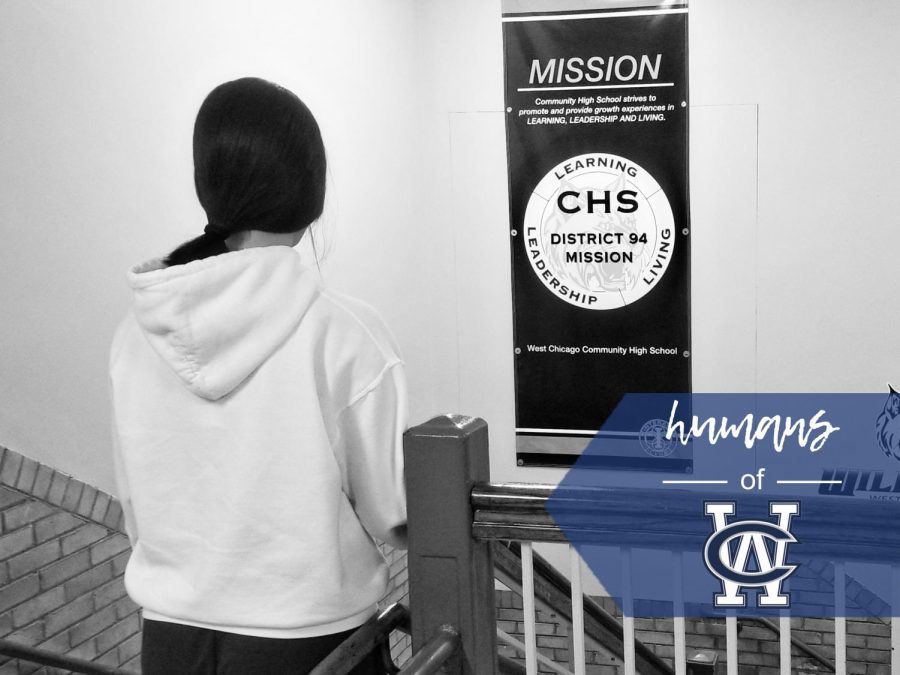Photo by Mark Poulterer
“Lucia” walks from her class on the third floor at West Chicago Community High School.
Behind every student at WEGO, there is a story:
January 27, 2023
Humans of WEGO is a section of the Wildcat Chronicle focused on telling other people’s stories. For the first time, the newspaper is publishing in both English and Spanish to represent the voices of all West Chicago Community High School’s students, and to give “Lucia”, whose name has been changed to protect confidentiality, a voice.
Special thanks to reporter Amanda Perez for her contributions to this article.
Humans of WEGO es una sección de Wildcat Chronicle enfocada en contar las historias de otras personas. Por primera vez, el periódico se publica tanto en inglés como en español para representar las voces de todos los estudiantes de la West Chicago Community High School, y para darle una voz a “Lucía”, cuyo nombre ha sido cambiado para proteger la confidencialidad.
Un agradecimiento especial a la reportera Amanda Pérez por sus contribuciones a este artículo.
Here is Lucia’s story.
The mud. Filthy water. Trees with branches that scratched and ripped clothing. These were just small obstacles along the Darien Crossing on a greater journey now-high school freshman Lucia endured almost a year ago as she and her family sought to better their lives in the United States.
It was June 29, 2022 when Lucia and her family left their home in Venezuela and crossed the Darien Gap, a notoriously dangerous passage through the mountains and swamps between Colombia and Panama. Making the crossing was a hard decision for the family, particularly because of the life-threatening risks associated with the journey.
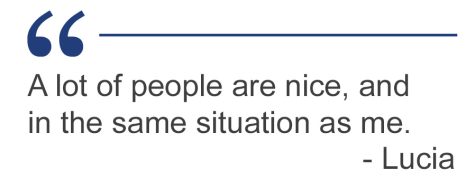 More than 151,000 migrants crossed the Darien Gap border between January and September of last year, and a large number of those migrants were Venezuelans leaving their country due to the humanitarian crisis faced there. At least 10% of Venezuelans have fled in recent years due to political instability, poverty, and increasing criminal activity.
More than 151,000 migrants crossed the Darien Gap border between January and September of last year, and a large number of those migrants were Venezuelans leaving their country due to the humanitarian crisis faced there. At least 10% of Venezuelans have fled in recent years due to political instability, poverty, and increasing criminal activity.
Lucia, now a West Chicago Community High School student, endured those obstacles and more in order to better her and her family’s lives.
Crossing the Darien Gap is difficult because of the violence and multitude of threats to those making the trek. According to Lucia, numerous people die from snake bites and drowning. Not only that, but the rainforest extends more than sixty miles, and the human body can only go so long without eating – walking day and night to make it across.
The journey is extremely nerve-racking because individuals are unsure where they are going to be able to get in on the border, Lucia explained. Consequently, the unknowns in this cross are endless, and no one is able to predict the dangers these families could face.
Last summer, Lucia traveled with her immediate family, including her little brother, who was eight at the time.
“He thought it was an adventure and fun. He was actually happy about it,” said Lucia.
However, this was not the case for Lucia and her parents. The fear they felt as they made the dangerous crossing in an attempt for a better life in America was palpable. The environment along the Darien Gap is one of fear, especially for families with small children, babies or pregnant women. Lucia and her family did not know how much walking (65 miles), or what kind of drawbacks they would endure when they reached some of the crossing’s notorious rivers.
“It wasn’t like they told us. They told us it could be very dangerous, high and deep. But really, when we passed, I don’t know if it was a coincidence or whatever, but the water was very low and reached almost to my hips and there was no current. And thank God, there were people who helped us, and it was very easy. I think it was the easiest part of the whole trip. It was just walking around, getting a little wet. When we got to the other side, I saw a man and he was telling us the way to enter,” said Lucia.
Despite potential drug traffickers and terrorist groups, the sense of community along the crossing was evident for her family. Lucia recalled many of the people she encountered through this process, pointing out that each had the same goal: never turning back, and making it to the other side.
“A lot of people are nice, and in the same situation as me. It was really cool to meet many different cultures,” said Lucia.
After reaching the other side of the Darien Gap, Lucia’s family made their way to Mexico. They stayed there for two weeks, resting before crossing the United States border.
When they reached America, Lucia and her extended family were finally reunited – permanently. For a year prior, her father had been living in America, preparing for his family to arrive. As a result, the rest of the family was able to settle into life in America with some ease.
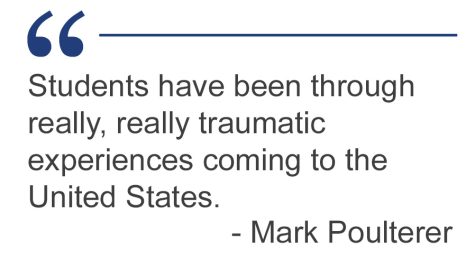 Lucia was enrolled in a number of classes at WEGO, and is working to develop her English language skills in ESL classes. One of her teachers, Mark Poulterer, was struck by her story, which he found both familiar and inspiring.
Lucia was enrolled in a number of classes at WEGO, and is working to develop her English language skills in ESL classes. One of her teachers, Mark Poulterer, was struck by her story, which he found both familiar and inspiring.
“Most of my students have crossed. They all came here from different countries, and each of their stories [is] different. Some of them get on an airplane and fly out here, and it is no big deal. Other students have been through really, really traumatic experiences coming up to the United States, crossing through the desert to get here…and some of them, it takes a few times where they can get across the border, so there are a whole bunch of stories,” said Poulterer.
For Lucia, the journey was entirely worth any hardships, and she points to the many ways in which her life has changed for the better.
One of the biggest changes is the chance for an education.
“It is a big difference, definitely. It’s really good. More opportunities and learning more in the United States,” said Lucia.
Although there may be days that she misses those family members still living in Venezuela, Lucia would not change her circumstances: she has the opportunity to strive for a better life, and earn a quality education in America. Whilst the journey was immensely difficult, Lucia says would not change anything. She believes she is now living her best life in the United States.
Esta es la historia de Lucía.
El barro. Agua sucia. Árboles con ramas que arañaban y rasgaban la ropa. Estos fueron solo pequeños obstáculos a lo largo del cruce de Darién en un viaje más grande que ahora-la estudiante de primer año de secundaria que Lucia soportó hace casi un año mientras ella y su familia buscaban mejorar sus vidas en los Estados Unidos.
Fue el 29 de junio de 2022 cuando Lucía y su familia abandonaron su hogar en Venezuela y cruzaron el Tapón del Darién, un paso notoriamente peligroso a través de las montañas y pantanos entre Colombia y Panamá. Hacer el viaje fue una decisión difícil para la familia, especialmente debido a los riesgos de muerte asociados con el viaje.
Más de 151.000 migrantes cruzaron la frontera del Tapón del Darién entre enero y septiembre del año pasado, y gran parte de esos migrantes eran venezolanos que salían de su país por la crisis humanitaria que se vive allí. Al menos el 10% de los venezolanos han huido en los últimos años debido a la inestabilidad política, la pobreza y el aumento de la actividad delictiva.
Lucía, ahora estudiante en West Chicago Community High School, soportó esos obstáculos y más para mejorar su vida y la de su familia.
Cruzar el Tapón de Darién es difícil debido a la violencia y la multitud de amenazas a quienes cruzan. Según Lucía, muchas personas mueren por mordeduras de serpientes y ahogamientos. No solo eso, sino que la selva tropical se extiende por más de sesenta millas, y el cuerpo humano solo puede pasar tanto tiempo sin comer, caminando día y noche para cruzar.
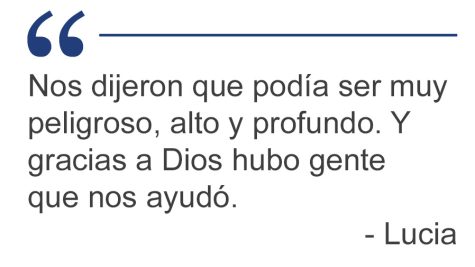
El viaje es extremadamente estresante porque las personas no están seguras por dónde podrán ingresar a la frontera, explicó Lucía. En consecuencia, las incógnitas en esta cruz son infinitas y nadie es capaz de predecir los peligros que estas familias podrían enfrentar.
El verano pasado, Lucía viajó con su familia más cercana, incluido su hermano pequeño, que en ese momento tenía ocho años.
“El ensó que era una Aventura y divertido. De hecho, estaba feliz por eso,” dijo Lucía.
Sin embargo, este no fue el caso de Lucía y sus padres. El miedo que sintieron mientras realizaban el peligroso viaje en un intento por una vida mejor en Estados Unidos era palpable. El entorno a lo largo del Tapón de Darién es aterrador, especialmente para las familias con niños pequeños, bebés o mujeres embarazadas. Lucía y su familia no sabían cuánto caminaron (65 millas) ni qué tipo de inconvenientes enfrentarían cuando llegaran a algunos de los ríos notorios en el cruce.
“No fue como nos dijeron. Nos dijeron que podía ser muy peligroso, alto y profundo. Pero realmente, cuando pasamos, no sé si fue casualidad o lo que sea, pero el agua estaba muy baja y me llegaba casi a las caderas y no había corriente. Y gracias a Dios hubo gente que nos ayudó y fue muy fácil. Creo que fue la parte más fácil de todo el viaje. Ella estaba caminando, mojándose un poco. Cuando llegamos al otro lado, vi a un hombre y nos estaba indicando el camino para entrar,” dijo Lucía.
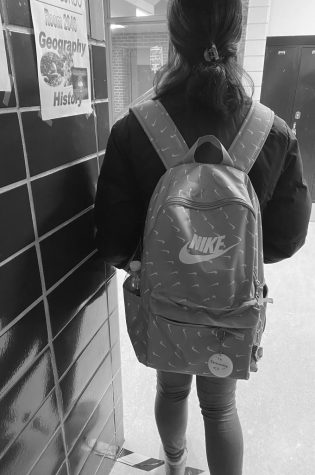
Lucía sale de su clase de geografía en enero de 2023. Ha logrado un progreso significativo como estudiante en WEGO y recientemente pasó a ESL 3 después de solo un semester en su clase anterior. (Photo by Sasha Baumgartner)
A pesar de los posibles narcotraficantes y grupos terroristas, el sentido de comunidad a lo largo del cruce era evidente para su familia. Lucía recordó a muchas de las personas que conoció durante este proceso y señaló que cada una tenía el mismo objetivo: nunca Volver atrás, y llegar al otro lado.
“Muchas personas son amables y están en la misma situación que yo. Fue genial conocer muchas culturas diferentes,” dijo Lucía.
Tras llegar al otro lado del Tapón del Darién, la familia de Lucía se dirigió a México. Permanecieron allí durante dos semanas, descansando antes de cruzar la frontera con Estados Unidos.
Cuando llegaron a los Estados Unidos, Lucía y su familia extendida finalmente se reunieron de forma permanente. Durante un año antes, su padre había estado viviendo en los Estados Unidos, preparándose para la llegada de su familia. Como resultado, el resto de la familia pudo adaptarse a la vida en los Estados Unidos con cierta facilidad.
Lucía se inscribió en varias clases en WEGO y está trabajando para desarrollar sus habilidades en el idioma inglés en clases de ESL. Uno de sus maestros, Mark Poulterer, quedó impresionado por su historia, que le resultó familiar e inspiradora.
“La mayoría de mis estudiantes han cruzado. Todos vinieron aquí de diferentes países, y cada una de sus historias [es] diferente. Algunos de ellos se suben a un avión y vuelan aquí, y no es gran cosa. Otros estudiantes han pasado por experiencias muy, muy traumáticas para llegar a los Estados Unidos, cruzar el Desierto para llegar aquí… y para algunos de ellos, se necesita varias veces para cruzar la frontera, por lo que hay muchas historias,” el dija.
Para Lucía, el viaje valió totalmente la pena y señala las muchas formas en que su vida ha cambiado como resultado.

